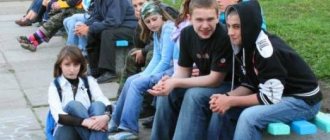Reports of child cruelty are increasingly in the news, with cases of bullying, mass beatings and assaults among teenagers on the rise across the country. Psychologists explain this behavior by dangerous age, family upbringing and erased boundaries of what is permitted.
In Nizhny Tagil on February 3, 10 teenagers, mostly boys, beat a girl from their school. They kicked her and hit her in the face; this was filmed by a resident of one of the neighboring houses. At first, the woman simply filmed the beating on her phone, and then from the window she threatened the teenagers with the police. After the recording spread on social networks, law enforcement officers became interested in this video.
The next day it turned out that the victim was a 13-year-old seventh-grade student at a local school, and her offenders were 12-15-year-old boys from the same educational institution. Moreover, one of the teenagers was already registered with the juvenile affairs department. The injured girl, according to some sources, lives with her grandmother, and her mother has been deprived of parental rights. The schoolgirl did not tell anyone about the fight.
Up to 1 year
Causes of aggression: hunger, intestinal colic, fear, feeling of insecurity, the need for constant confirmation of maternal love.
Ways of expression: crying, screaming.
What to do: feed, pick up, caress, smile, talk. Be with your child more often; even while at home, carry it on your stomach or back in a backpack or move it behind you in a high chair.
What not to do: do not leave a crying child unattended; don't yell at him; do not soothe with a pacifier; do not frighten with loud sounds and sudden movements; do not impose your will on him in the game.
If the “victim” provokes cruelty?
There are also cases when a “child-victim” specifically or for the purpose of protection provokes intrigues against him. In this case, the “ignoring tactic” (read more about it in this article ) would be useful, but the victim thinks differently. He tries to defend himself by saying offensive words in response, pushing, etc. But these actions only provoke “cruelty” towards oneself and “get it.” I’ll write below what to do in such cases.
Once again I ask parents (precisely parents, since the teacher is very busy and does not always see problems among children) to talk with their children, to be sincerely interested in their problems, and not to ask “how are things at school?” (he will say that it is normal).
1–1.5 years
Reasons for aggression: dissatisfaction with the imposed restrictions and prohibitions.
Ways of expression: stubbornness, refusal to eat and sleep, waking up at night, crying.
What to do: explain each “no” clearly and restrainedly; be an authoritative but not authoritarian leader; encourage but control children's curiosity and exploration; come to the aid of a crying child with all possible haste.
What not to do: never forcefully shake a child by the shoulders (this can lead to brain hemorrhage); do not submit yourself completely to his will; Don't let him cry for a long time.
Why children are cruel: the real reasons
Child cruelty is frightening, causing misunderstanding, aggression and powerlessness. And the instinctive desire to destroy the source of all these feelings. But what is hidden from our eyes is that behind such childish manifestations there is always adult cruelty.
Alexandra Sanitskaya
psychologist, Gestalt and EMDR therapist
A child is driven to sadism by his experience of physical or psychological violence, situations when he could not respond, defend himself, or complain about mistreatment.
Or the child witnessed cruelty towards someone close and suffered from the inability to stop what was happening. And when the internal tension of such children reaches its limit, “acting out” appears in the form of cruel acts.
This can be torturing others or self-torture (that is, cruelty to oneself).
No longer able to be a victim, the child, in order to save himself from internal tension, becomes an aggressor towards those whom he can. He tries to take power into his own hands, to ease the pain overwhelming him by inflicting it on others. Sometimes he begins to torment his parents in return, sometimes he torments children and animals.
But in any case, the rage that is directed at others is the result of childhood powerlessness in front of one’s own enemy and abandonment.
How does it happen that we notice cruel children, but do not notice our own cruelty in dealing with children?
Sometimes cruelty looks like physical violence, the use of force. Then it's a little easier to notice. Sometimes it is psychological violence, use, humiliation, being left alone, meaningless punishments, etc. Trampling and devaluing strong feelings, coldness towards experiences, ridicule or jokes. Surely you can remember how you yourself found yourself in situations where you were hurt and offended by what others were doing, but everyone around you was indifferent to you or had fun at your feelings. How did you feel then? How did you feel?
Now imagine that you feel this constantly, without the ability to stop. Or imagine that physical violence is mixed into this. Then you want to do anything just to stop.
Therefore, we unconsciously repress memories of how bad it was for ourselves. Precisely because it hurt, but I don’t have the strength to remember this pain. And there is absolutely no hope of sharing it with someone. Sometimes, even realizing our own cruelty, we are afraid to admit it, we are ashamed to ask for help, we try to stop, but we cannot. Their own aggressiveness and cruelty turns out to be uncontrollable for those adults who, in childhood, had some significant adult who was spontaneous, terrible, and uncontrollably aggressive.
If we are talking about a cruel person, then this is by no means a strong person.
This is a person who avoids weakness so much that he takes the opposite side, he tries in every possible way to destroy everything weak that he sees as a reminder of his own painful experience of weakness.
A sadist cannot sympathize, empathize, take the place of another and imagine/remember himself in similar situations. Because your own ghosts of the past are so terrifying that the psyche will simply crowd out the possibility of sympathy, leaving only the part that is furious.
And empathy is exactly what a cruel child or adult was once deprived of.
Those parents who are faced with their own cruelty often honestly cannot admit to themselves that this happens in moments when they themselves are scared, helpless, and in despair cannot cope with something. Because they don’t know how to experience these states normally, without falling into passion.
When cruelty appears in a child, the most difficult thing is not to consider it separately, rejecting it and considering it bad, but to try to look at the family as a system in which, for some reason, sympathy, powerlessness and weakness are impossible. Or at himself, as a person who for some reason has ceased to be sensitive to his own cruelty.
And start moving towards change, overcoming your own horror. Because you will have to remember your experience. Look for repressed pain, without which it is impossible to restore sensitivity to violence and learn to sympathize.
This text was originally published on the website Mamsila.ru. We publish it with the permission of the editor.
Read more on the topic
“Life was hard and poor, and provoked a lot of violence, which now needs to be explained”: how to read classic books with dubious (by modern standards) plots with children
What is abuse and how to recognize it: a selection of books about domestic violence
6 films about bullying and cyberbullying
Who are we and where can you read us?
After all, we have not only a website!
1.5–3 years
Causes of aggression: the child’s beginning self-identification; conflict of unsatisfied children's desires and needs with the will and views of the parents.
Ways of expression: screaming, kicking, pinching, biting, scratching, hitting toys.
What to do: do not suppress rage, but let it splash out; call the child to order calmly, kindly and firmly; play more with the child.
What not to do: do not make fun of the child’s rage, do not respond with aggression.
How to deal with the offender?
Only if the cruelty does not go beyond the limit and does not become bullying, conversations with a psychologist or any other person authoritative for the child will help. The main thing is that the parents of the “victim” do not start a showdown themselves! Let him ignore the actions of the offender; over time, the interest in bullying will disappear. If there is no reaction from the victim, will it be interesting to do something further (even in a negative sense)? If the “victim” herself provokes the offender, then it is worth telling the latter not to react to these provocations. The offender will remain guilty and punishment may be applied to him. And this can be avoided if the “offender” adheres to the “ignoring tactics” . Say that “you will be wiser, and therefore will be respected, because you avoid unnecessary conflicts . If the conflict is not resolved peacefully, conversations with specialists do not lead to the desired result - write a statement to the director or head teacher against the offender .
Remember that if your child is cruel, reconsider your behavior (you yourself are rude or too caring). If it began to appear in adolescence, it will go away over time. If it crosses boundaries, contact specialists.
Raising a child and developing his personality is in many ways a reflection of your upbringing. If you want to see your child well-mannered, smart, kind, work on yourself first, then the rest will be much easier.
Thank you for your attention, may your children always make you happy.
3–6 years
Causes of aggression: irrepressible energy, constant thirst for knowledge of the world and communication; jealousy of mother.
Ways of expression: swear words, crying, whims.
What to do: talk to your child more, but avoid moralizing and lecturing; develop his sense of humor. Starting at age 5, most children learn new, less barbaric ways of communicating.
What not to do: do not succumb to provocation and ignore swear words, do not use foul language in the presence of a child; do not leave him alone for a long time, but resort to the help of other family members or invite a nanny.
The norm of child cruelty - what is it?
Yes, sometimes it’s normal. Remember yourself, did you always hide your dislike for them from others as a child? Most likely you wanted to express it in one way or another. If you didn’t like someone, they could call you names, push you, or ruin the thing. Is it possible to explain why you didn’t like your desk neighbor? I just didn't like it. As a child, people are judged one-sidedly - from a low-income family, with physical disabilities, a nerd, a traitor, etc. Any of these signs in a school environment can give rise to expressions of cruelty. The most alarming time for a parent is when childhood cruelty begins to actively manifest itself - the period of study in grades 4-7. Children are no longer quite children, but they are not yet boys and girls. In most cases, “calling names”, “pushing”, etc. pass as the child emerges from adolescence. The main thing is to understand that this cruelty is “age related”.
7–12 years
Causes of aggression: natural (age-related) aggressiveness.
Ways of expression: squabbles with peers, fussing, fighting.
What to do: direct the child’s energy to outdoor games, classes in sections and clubs; teach him to put emotions into verbal form; focus on social values; dose your time watching TV programs and computer games.
What not to do: do not shame a child if he failed to win in a fight; do not allow him to watch television programs with scenes of excessive cruelty and violence; do not encourage passion for too “bloody” video games.
Family and society
At the same time, according to a child psychiatrist, only the family and society can be blamed for the cruel behavior of children. Portnova is sure that children are only as cruel as their parents.
“It all starts with a discussion in the family, some comments, or the reluctance of parents to have, for example, a child with special needs in a kindergarten group or class. Children see this, absorb it, naturally, they form the same attitude towards people who are different from them in some way. This starts not with children, but with their parents and state policy,” she explained.
Irina Taranova is sure that if parents are actually involved in raising a child - forming moral values, systems and rules of behavior, paying attention to the child’s mood swings, paying attention to what happens to him - cases of cruelty and intolerance will be easier to avoid.
Anna Portnova added that in the end, the consequences of a disgusted or disrespectful attitude towards people with disabilities and people with special needs will affect those who instilled this attitude in their children.
When you become old, you write under yourself, the child will kick you, call you names and send you to a nursing home. Children who are not taught to be merciful, kind and tolerant will continue to be treated that way.
Anna Portnova.
For example, in Buryatia, a 14-year-old teenager killed his stepfather. The man periodically beat the boy's mother, so that he could not stand it. He could only intercede and stop the 58-year-old man with a weapon in his hands. A murder case was opened against the boy.
Anna Portnova is also confident that today's Russian society has developed tolerance for violence.
“From morning to evening, a person listens on the news about how people were killed, dismembered, and billions were stolen... [A person can say to himself:] “Just think, I stole something from a store, tripped someone up, this is nothing compared to what what’s happening in the country,’” she added.
Even the example of the beating of a girl in Nizhny Tagil showed that people are reluctant to stand up for victims of bullying and beatings: despite the fact that the woman who filmed the fight on video threatened to call the police, the investigative authorities did not receive any complaints. Only public outcry set the matter in motion.
On February 4, a video of another beating also appeared on social networks: in the classroom, in the absence of the teacher, a girl shouts at a classmate, hits her in the face, pulls her hair and calls her names. No one interfered in their conflict, and the boys even encouraged the offender.
What happens to the psyche during adolescence
During the period from an average of 10 to 18 years, the development of internal organs and systems acquires qualitative changes, hormonal changes begin, new social instincts begin to appear, and sexual behavior is formed. All this is reflected in the mental sphere. Almost all mental functions change.
Attention to things that were previously uninteresting increases. The load on the emotional and volitional sphere increases, which makes it increasingly difficult to restrain and adapt. Thinking and personal characteristics change. This contributes to such adolescent behavior characteristics as:
- protest reactions,
- attracting attention to oneself,
- realization of energy unspent in a normal way,
- intolerance.











